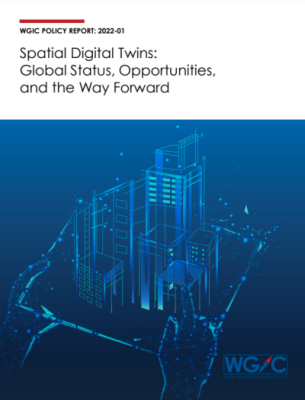Today, the World Geospatial Industry Council released their latest report, honing in on a much-discussed topic across many industries: the digital twin. By combining industry research, global market assessments, and detailed work with Subject Matter Experts (SMEs), the research explores how digital twins have evolved, how they are being used, and how they could benefit from the addition of accurate spatial data. The full report is available to download here.
 Digital twins, as defined in this report (and mostly agreed upon across the industry) are “evolving, virtual representations of an object or process” that uses data that is updated from real-world observations and inputs. Beyond simply a static digital copy, digital twins are designed to be updated continuously to make sure that the digital and real stay in synch. With the cost of technologies such as IoT sensors and laser scanning decreasing, the interest in digital twins has been growing and their use cases broadening.
Digital twins, as defined in this report (and mostly agreed upon across the industry) are “evolving, virtual representations of an object or process” that uses data that is updated from real-world observations and inputs. Beyond simply a static digital copy, digital twins are designed to be updated continuously to make sure that the digital and real stay in synch. With the cost of technologies such as IoT sensors and laser scanning decreasing, the interest in digital twins has been growing and their use cases broadening.
So where does geospatial data play a part in, say, a digital twin of a building or power plant?
The report makes the case that across nearly all digital twins, there is an opportunity for digital twins and their visualizations to benefit from the addition of spatial data. When a digital twin includes dimensionally accurate and spatially-positioned elements, including the location of sensors and other inputs, additional applications can be unlocked. This positional accuracy also paves the way for the connection of assets together - allowing for the aggregation of local, regional or even global-scale digital twins.
The report calls these spatially-enhanced digital twins ‘Spatial Digital Twins’ - and define them as digital twins that include “spatial context” and provide a “location-based representation of assets, infrastructure and systems.” Rather than existing on a blank white page, buildings can be viewed in their geospatial surroundings, and can be positioned in relation to nearby assets. Spatial Digital twins don’t have to be limited to single buildings or built world assets, either, opening the doors for digital twins of larger infrastructure systems, entire cities, countries (as we’ve already seen with the national digital twin of Singapore), and even perhaps, the globe.
“Although Spatial Digital Twins are often used for planning, lifecycle management and monitoring tools in a “Smart City” or similar context, Spatial Digital Twins can also be applied in other domains and/or broader ecosystems (e.g., agriculture, energy, natural resources management, transport, etc.). For example, the European Union, in late 2020, announced an initiative called Destination Earth (DestinE) to build a “Digital Twin” of the globe at a 1-kilometer resolution to simulate the atmosphere, ocean, ice, and land, and to forecast floods, droughts, and fires, from days to years in advance, and attempt to model human behavior, enabling leaders to see the impacts of weather events and climate change on society, as well as gauge the effects of different climate policies.”
While digital twins are a relatively new technology, they’ve been available across many industries for long enough to get some validity and traction. The use cases outlined in the report span a stunning breadth of industries and purposes - and enhancing those with accurate geospatial data (if they are not already capable) is a big business opportunity as well.
The WGIC report research identified that in 2021 digital twins were associated with $12.7 Billion in revenue, with an $8 Billion addressable market for the geospatial industry. This is also projected to grow - moving to $45 Billion by 2026 with a $25 Billion geospatial market for digital twins.
But to bring the digital twins to the next level requires the geospatial groundwork to be laid for the smart cities, digitally-connected communities and other use cases the report identifies, as well as confronting the lack of standardization with both geospatial data and digital twin platforms. By having open standards, spatial digital twins can better guarantee their compatibility with each other and integration with IoT and other inputs.

Research and input from the report’s SMEs also found there is a strong benefit to both unlocking value and enabling increased usability of almost all Digital Twins through the fundamental use of spatial data.
The report outlines three key findings:
- All advanced digital twin use cases rely on spatial data (spatial digital twins)
- Geospatial data is fundamental to unlocking more applications from existing or individual digital twin ecosystems
- Spatial data capture services by the geospatial industry can enable improved visualization with low-cost alternatives.
The report also presents a wide variety of use cases of digital twins already in action (from scanning inaccessible infrastructure, to creating a digital shipping hub, to city planning and more).
To download the full report: Click Here






